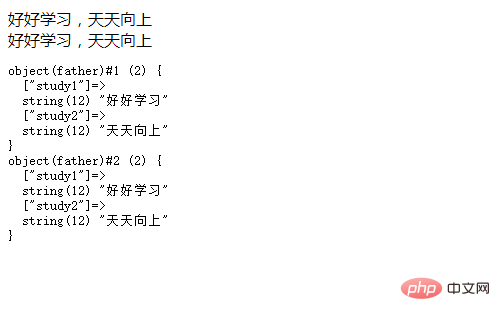 Backend Development
Backend Development
 PHP Tutorial
PHP Tutorial
 The use of clone keyword and __clone() method in PHP (detailed examples)
The use of clone keyword and __clone() method in PHP (detailed examples)
The use of clone keyword and __clone() method in PHP (detailed examples)
In the previous article, I brought you "Namespace Definition and Use in PHP (Detailed Examples)", which introduced the definition and use of namespace in PHP in detail. This article This article continues to show you the relevant knowledge in PHP, about the use of clone keyword. I hope everyone has to help!

In our previous study, there were many keywords, such as $this, $new, etc. Today we continue to look at the keyword clone, which is also commonly used in PHP. Before learning the clone keyword, we need to know that the object model in PHP calls objects by reference, but we also need to create a copy of the object. The purpose is to avoid affecting the object copy when the original object changes. .
At this time, if you use the new keyword, you can re-create the object, and then assign the same value to the attribute. It can also play the role of creating a new copy, but this method is not only troublesome but also error-prone. , at this time we hope that PHP can have an identical object, and the two do not interfere with each other, which is what we think of as a clone. How should this be achieved? Don't panic, keep watching.
<strong><span style="font-size: 20px;">clone</span></strong>Keywords
We hope There is a copy that does not interfere with the original object. In PHP, you can clone the object through the clone keyword.
cloneThe syntax format of the keyword is as follows:
克隆对象名称 = clone 原对象名称;
You can understand the cloning action as copying the memory area of the object, and the assigned object is the same as the original Objects are independent of each other. And the member methods, properties and values between them are exactly the same.
Next, let’s take a look at the capabilities of clone through a simple example. The example is as follows:
<?php
class father{
public $study1, $study2;
public function __construct($study1, $study2){
$this -> study1 = $study1;
$this -> study2 = $study2;
}
public function output(){
echo $this -> study1.','. $this -> study2.'<br>';
}
}
$obj = new father('好好学习', '天天向上');
$obj2 = clone $obj;//克隆$obj
$obj -> output();
$obj2 -> output();
echo '<pre class="brush:php;toolbar:false">';
var_dump($obj);
var_dump($obj2);
?>Output result:

What we need to note is that if you use = to assign an object to a variable, then what you get will be a reference to the object. Changing the value of the attribute through this variable will affect the original object. So you still have to use clone, changing the attribute value will not affect the original object.
Through the above examples, we already know how to clone an object for our use. However, after the object is successfully cloned, its properties, member methods, and values will be exactly the same as the original object. Then At this time, we just say that changing attributes will not affect the original object, but how should we reassign the attributes of the cloned copy members? At this time we will use the __clone() method in the PHP magic method.
<strong><span style="max-width:90%">__clone()</span></strong>Method
__clone() method cannot be called directly. Only clone has __clone(). Only when an object is cloned through the clone keyword, Only then can the __clone() method be called through this cloned object.
<?php
class father{
public $name, $url;
public function __construct($name, $url){
$this -> name = $name;
$this -> url = $url;
}
public function output(){
echo $this -> name.','.$this -> url.'<br>';
}
public function __clone(){//通过__clone()来更改新对象的属性
$this -> name = '福如东海';
$this -> url = '寿比南山';
}
}
$obj = new father('好好学习', '天天向上');
$obj2 = clone $obj;
$obj -> output();
$obj2 -> output();
?>
__clone() in the class with access rights of private (private). method, it can achieve the purpose of prohibiting cloning.
PHP Video Tutorial" to learn more about PHP knowledge.
The above is the detailed content of The use of clone keyword and __clone() method in PHP (detailed examples). For more information, please follow other related articles on the PHP Chinese website!

Hot AI Tools

Undresser.AI Undress
AI-powered app for creating realistic nude photos

AI Clothes Remover
Online AI tool for removing clothes from photos.

Undress AI Tool
Undress images for free

Clothoff.io
AI clothes remover

Video Face Swap
Swap faces in any video effortlessly with our completely free AI face swap tool!

Hot Article

Hot Tools

Notepad++7.3.1
Easy-to-use and free code editor

SublimeText3 Chinese version
Chinese version, very easy to use

Zend Studio 13.0.1
Powerful PHP integrated development environment

Dreamweaver CS6
Visual web development tools

SublimeText3 Mac version
God-level code editing software (SublimeText3)

Hot Topics
 1668
1668
 14
14
 1428
1428
 52
52
 1329
1329
 25
25
 1273
1273
 29
29
 1256
1256
 24
24
 PHP: A Key Language for Web Development
Apr 13, 2025 am 12:08 AM
PHP: A Key Language for Web Development
Apr 13, 2025 am 12:08 AM
PHP is a scripting language widely used on the server side, especially suitable for web development. 1.PHP can embed HTML, process HTTP requests and responses, and supports a variety of databases. 2.PHP is used to generate dynamic web content, process form data, access databases, etc., with strong community support and open source resources. 3. PHP is an interpreted language, and the execution process includes lexical analysis, grammatical analysis, compilation and execution. 4.PHP can be combined with MySQL for advanced applications such as user registration systems. 5. When debugging PHP, you can use functions such as error_reporting() and var_dump(). 6. Optimize PHP code to use caching mechanisms, optimize database queries and use built-in functions. 7
 PHP and Python: Comparing Two Popular Programming Languages
Apr 14, 2025 am 12:13 AM
PHP and Python: Comparing Two Popular Programming Languages
Apr 14, 2025 am 12:13 AM
PHP and Python each have their own advantages, and choose according to project requirements. 1.PHP is suitable for web development, especially for rapid development and maintenance of websites. 2. Python is suitable for data science, machine learning and artificial intelligence, with concise syntax and suitable for beginners.
 PHP vs. Python: Understanding the Differences
Apr 11, 2025 am 12:15 AM
PHP vs. Python: Understanding the Differences
Apr 11, 2025 am 12:15 AM
PHP and Python each have their own advantages, and the choice should be based on project requirements. 1.PHP is suitable for web development, with simple syntax and high execution efficiency. 2. Python is suitable for data science and machine learning, with concise syntax and rich libraries.
 PHP in Action: Real-World Examples and Applications
Apr 14, 2025 am 12:19 AM
PHP in Action: Real-World Examples and Applications
Apr 14, 2025 am 12:19 AM
PHP is widely used in e-commerce, content management systems and API development. 1) E-commerce: used for shopping cart function and payment processing. 2) Content management system: used for dynamic content generation and user management. 3) API development: used for RESTful API development and API security. Through performance optimization and best practices, the efficiency and maintainability of PHP applications are improved.
 The Enduring Relevance of PHP: Is It Still Alive?
Apr 14, 2025 am 12:12 AM
The Enduring Relevance of PHP: Is It Still Alive?
Apr 14, 2025 am 12:12 AM
PHP is still dynamic and still occupies an important position in the field of modern programming. 1) PHP's simplicity and powerful community support make it widely used in web development; 2) Its flexibility and stability make it outstanding in handling web forms, database operations and file processing; 3) PHP is constantly evolving and optimizing, suitable for beginners and experienced developers.
 PHP and Python: Different Paradigms Explained
Apr 18, 2025 am 12:26 AM
PHP and Python: Different Paradigms Explained
Apr 18, 2025 am 12:26 AM
PHP is mainly procedural programming, but also supports object-oriented programming (OOP); Python supports a variety of paradigms, including OOP, functional and procedural programming. PHP is suitable for web development, and Python is suitable for a variety of applications such as data analysis and machine learning.
 PHP vs. Other Languages: A Comparison
Apr 13, 2025 am 12:19 AM
PHP vs. Other Languages: A Comparison
Apr 13, 2025 am 12:19 AM
PHP is suitable for web development, especially in rapid development and processing dynamic content, but is not good at data science and enterprise-level applications. Compared with Python, PHP has more advantages in web development, but is not as good as Python in the field of data science; compared with Java, PHP performs worse in enterprise-level applications, but is more flexible in web development; compared with JavaScript, PHP is more concise in back-end development, but is not as good as JavaScript in front-end development.
 PHP and Python: Code Examples and Comparison
Apr 15, 2025 am 12:07 AM
PHP and Python: Code Examples and Comparison
Apr 15, 2025 am 12:07 AM
PHP and Python have their own advantages and disadvantages, and the choice depends on project needs and personal preferences. 1.PHP is suitable for rapid development and maintenance of large-scale web applications. 2. Python dominates the field of data science and machine learning.



